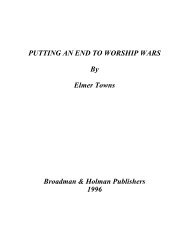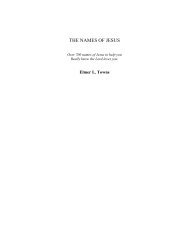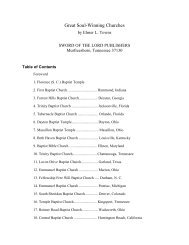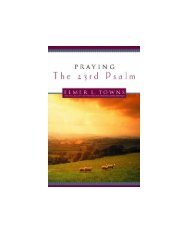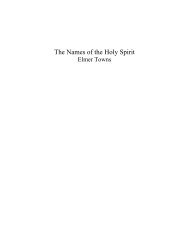A Journey Through The Old Testament - Elmer Towns
A Journey Through The Old Testament - Elmer Towns
A Journey Through The Old Testament - Elmer Towns
You also want an ePaper? Increase the reach of your titles
YUMPU automatically turns print PDFs into web optimized ePapers that Google loves.
Though the Scripture explains, “Now Terah lived seventy years, and begat Abram, Nahor,<br />
and Haran” (Gen. 11:26), it appears that only the oldest of these sons was born that early in the<br />
life of Terah. By comparing other references to dates in the lives of Abram and Terah, Abram<br />
appears to have been the youngest son of Terah born some sixty years later (cf. 12:4; 11:32).<br />
When this son of his old age was born, Terah gave him the name Abram based on the words ab<br />
meaning “father” and the verb raham or its Babylonian equivalent remu meaning “he loves.”<br />
Literally the name means “he loves his father.” Because of the later greatness of Abraham, some<br />
have suggested his name should be understood as “beloved father” or “exalted father.”<br />
Abram was raised in a place identified as “Ur of the Chaldeans.” <strong>The</strong> name Ur was a<br />
common name for a city in that the Babylonian word for city was uru. Because of this there may<br />
have been many cities of that day identified as Ur. <strong>The</strong> most famous of these today is the<br />
archeological site of “the Babylonian Ur” at Mugheir near the Persian Gulf. Many contemporary<br />
scholars identify this Ur as the Ur of the Chaldeans in which Abram was raised. Others disagree<br />
with this conclusion for one or more reasons. Even if the Babylonian Ur was not Abram’s<br />
hometown, what archeologists have discovered there gives us some insight into the nature of<br />
cities in that day.<br />
REASONS FOR A NORTHERN LOCATION OF<br />
“UR OF THE CHALDEANS”<br />
1 Traditionally, until1850, Urfa near Haran in southern Turkey was considered the Ur of<br />
Abram. Geographic references in Scripture seem to support a northern location for Ur.<br />
2 <strong>The</strong> social-legal traditions of the patriarchs tend to point to a northern origin.<br />
3 Babylonian Ur never referred to as Ur of the Chaldeans in the cuneiform records found there.<br />
4 Lower Mesopotamia was not called Chaldea until 1,000 years after Abraham. Abraham lived<br />
in Mesopotamia before coming to Haran (Acts 7:2).<br />
5 When Abraham sent his servant to the land of his birth to find a wife for Isaac, he went to<br />
Haran (Gen. 24:4). Jacob later fled to Paddan Aram in the same area when fleeing from Esau.<br />
<strong>The</strong> family of Abram appears to have established themselves in the north.<br />
6 <strong>The</strong> ancient designation of a northern area as “Holdai” is thought to be related to the<br />
expression “of the Chaldeans.”<br />
7 <strong>The</strong> patriarchs are described as Arameans suggesting identification with a northern race (Jacob,<br />
Deut. 26.5, Laban, Gen. 31:47).<br />
8 <strong>The</strong> Babylonian Ur is on the wrong side of the Euphrates River according to Joshua’s<br />
description (Josh. 24:2-3).<br />
9 A tablet from Elba reportedly refers to an Ur of Haran.<br />
10 Chaldea is described in the context of several northern cities (cf. Gen. 22.22, Isa. 23:13).<br />
<strong>The</strong> city of Ur was a prosperous city during the time of Abram’s childhood. Excavations at<br />
that site have uncovered an abundance of both public buildings and comfortable private homes. It<br />
was a city of law and order and appears to have been both a producing and trading center. It was a<br />
center largely devoted to the moon god Nauna(r)-Sin. Many of the names associated with the cult<br />
of lunar worship including Terah, Sarah, Milcah, Nahor, Haran, and Laban.<br />
Terah himself was involved in worshiping and serving idols (Josh. 24:2). According to<br />
Jewish legend, Terah made idols until his son Abraham convinced him of the folly of worshiping a<br />
powerless idol. Terah’s decision, however, to leave Ur and dwell in Haran suggests he never<br />
abandoned his idol worship. Haran was one of the centers for the worship of the moon god. If the









